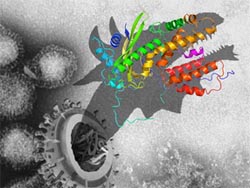
A research team led by CAS biologists has recently decoded the fine structure of a polymerase complex from an avian flu H5N1 virus, which may meet the urgent need for improved influenza therapeutics.
The experts reveal the 2.9 ångström (an ångström equals to 1×10−10 meter) structure of the complex, which resembles "a dragon's head" with clamped "open jaws", and propose a model to explore related viral replication and transcription mechanisms, according to their work published online in
Nature on July 9, 2008.
The highly pathogenic influenza A virus subtype H5N1 has caused global concern as a potential pandemic threat. So far, the H5N1 has killed millions of poultry in many Asian, European and African nations, and there has been a growing number of bird-to-human transmissions leading to clinically severe and fatal human infections since its first outbreak in 1997.
Since bird flu viruses are under constant variation, it is an arduous but urgent task to explore novel anti-flu therapeutics for both affected nations and the world.
The polymerase is an enzyme primarily responsible for the polymerization of new DNA or RNA against an existing template in the process of replication and transcription. The present study focuses on the influenza RNA-dependent RNA polymerase (RdRp) heterotrimer, which plays a key role in viral RNA replication and transcription.
The RdRp heterotrimer is composed of three proteins: PA, PB1 and PB2. Previous studies show PA's probable involvement in RNA replication and virus assembly. PB1 inhibits polymerase and endonuclease activities while PB2 is responsible for cap binding. Thanks to its highly conserved nature, the complex makes an ideal target for drug design.
To develop antivirus drugs, scientists need to first uncover the virus structures and their underlying replication mechanisms. In this case, the scholars report the crystal structure of H5N1 virus PA in complex with the PA-binding region of PB1. From their structure determination, they find that the C-terminal domain of PA (PAC) resembles a dragon's head with the N-terminal peptide of PB1 (PB1N) clamped into its open jaws. The dragon head can be further divided into domain I, the "brain", and domain II, the "mouth".
This structure demonstrates a significant PB1 binding region on PA, in which the amino acid residues are highly conserved, suggesting it is a feasible target for the design of a new generation of compounds that inhibit polymerase assembly and activity.
The authors propose a model for the RdRp heterotrimer by comparing PAC with a similar polymerase structure from a reovirus to further explore PA's role in viral replication and transcription.
It is a good beginning for scientists to further investigate the structure and function of the influenza virus polymerase, the paper notes.
Headed by Prof. LIU Yingfang with the CAS Institute of Biophysics (IBP) and CAS academician RAO Zihe, the breakthrough was done in China with assistance from Argonne National Laboratory of the US and the National University of Singapore.
The work is supported by the National Natural Science Foundation of China, the Ministry of Science and Technology International Cooperation Project and the National "973" Program.







